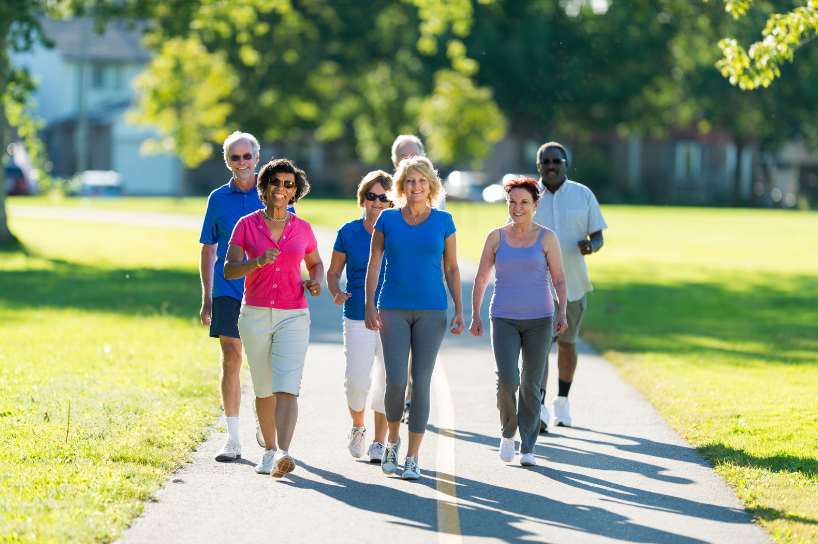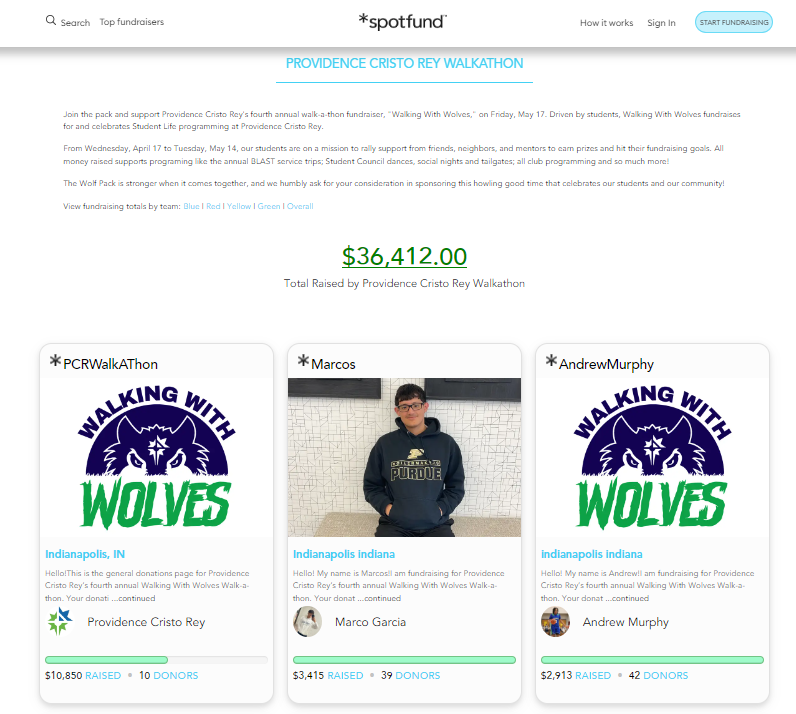Walk-a-thons are one of the most engaging and community-driven fundraising events nonprofits can host. Whether you're looking to raise funds for a specific cause or build awareness, these events offer an excellent way to bring people together for a good cause. In this guide, we’ll walk you through everything you need to know to plan and execute a successful walk-a-thon fundraiser, from setting goals to maximizing donations through online fundraising platforms.

What is a Walk-a-Thon?
A walk-a-thon is a fundraising event where participants raise money by walking a set distance, typically with sponsors pledging donations based on either the distance walked or a flat amount. Nonprofits can let participants walk as a way to engage supporters, raise awareness for their cause, and generate crucial funds. Participants range from individuals to families and teams, making walk-a-thon fundraisers accessible to a wide audience.
Walk-a-thons offer an interactive, health-focused way for communities to come together and support a cause. The emphasis on physical activity makes these events more dynamic and engaging than traditional fundraisers. They allow participants to feel directly involved while also promoting fitness and wellness, encouraging a strong sense of accomplishment. This hands-on approach can deepen the emotional connection between participants and the cause they’re supporting.
Benefits for Nonprofits of All Sizes
For both large and small organizations, walk-a-thons provide numerous benefits:
-
Low Overhead Costs: Hosting a walkathon fundraiser typically requires minimal setup and resources compared to elaborate fundraising events, making it budget-friendly for smaller nonprofits.
-
Scalable Participation: Walk-a-thons can accommodate any number of participants, from intimate community groups to large-scale events. This makes them suitable for nonprofits with varying supporter bases.
-
Community Engagement: Walk-a-thons provide an opportunity to engage with local communities, bringing people together around a common cause. The social aspect of the event fosters a sense of belonging, making supporters more likely to stay connected with the organization in the long term.
Why Host a Walk-a-Thon?
Cost-Effective Fundraising
One of the primary reasons nonprofits choose to host walk-a-thons is their cost-effectiveness. Unlike elaborate galas or complex auctions, walk-a-thons require minimal upfront investment. Many events can take place in public parks, school tracks, or other open spaces, eliminating the need to rent costly venues. Additionally, volunteers often handle much of the event coordination, reducing staffing expenses. This simplicity allows organizations to focus on raising funds while keeping overhead low.
-
Leverage Public Spaces: Many communities have free or low-cost outdoor spaces that can be used for a walkathon event, making location setup affordable and accessible.
Engages All Age Groups
Walk-a-thons are uniquely versatile in their appeal, attracting participants of all ages and backgrounds. Whether it’s families with young children, schools, or corporate teams, walk-a-thons offer an inclusive, low-pressure environment for everyone to participate.
-
Family-Friendly and Inclusive: Families can join together, making the event appealing for parents looking for activities with their kids. Schools can also integrate walk-a-thons into physical education programs or fundraising initiatives.
-
Corporate Teams: Many companies encourage team participation in local community events, offering walk-a-thons an opportunity to bring in corporate donations and employee engagement. The low physical intensity also makes the event accessible for varying fitness levels, promoting inclusivity.
Social Media and Virtual Tie-ins
With the increasing role of technology in fundraising, walk-a-thons have expanded beyond physical events into digital spaces. Promoting the event online can significantly boost participation and donations. Social media platforms provide an excellent way to spread the word, showcase participant stories, and encourage friendly competition through team challenges. Additionally, nonprofits can use virtual tie-ins, like online fundraising platforms, to enhance the experience.
-
Promote via Social Media: Social platforms allow for easy event sharing, participant updates, and real-time engagement during the walk-a-thon.
-
Integrating Online Fundraising Platforms: By using platforms like *spotfund, nonprofits can streamline donation collection while encouraging participants to share their own fundraising pages. This peer-to-peer aspect motivates donors to contribute, as they feel more directly connected to the individual or team they're supporting.

Step-by-Step Guide to Organizing a Walk-a-Thon
1. Set Your Goals
Before you begin planning, it’s crucial to establish clear fundraising and participation goals. Having defined objectives will guide your decision-making and help measure the event's success.
-
Fundraising Targets: Set a realistic donation goal based on your organization's needs and the size of the participant base you expect. Break this goal into smaller, manageable milestones to track progress.
-
Participation Targets: Consider how many participants you'll need to reach your fundraising goal. For example, if each participant is expected to raise a certain amount, calculate how many walkers or teams will be required to meet your target.
2. Choose the Right Location
Selecting a location is one of the most critical steps in organizing a walk-a-thon. The venue should be safe, accessible, and capable of accommodating the number of participants you expect.
-
Accessible and Safe Routes: Choose a location that is easy for participants to get to, such as public parks, school tracks, or community centers. The route should be well-marked and safe, ideally free from heavy traffic or other potential hazards.
-
Consider Weather, Parking, and Permits: Take weather conditions into account when selecting a date and location, especially if it’s an outdoor event. Ensure that there’s enough parking for participants and spectators, and don’t forget to check if you need any permits or permissions from local authorities to host the event.
3. Create a Fundraising Strategy
A solid fundraising strategy is essential to the success of your walk-a-thon. Beyond just organizing the walk, you need to plan how to encourage donations and support.
-
Registration Fees: Charge a reasonable registration fee to cover event costs or as a direct donation to your cause. Offer early bird pricing to encourage early sign-ups.
-
Sponsorships: Partner with local businesses to sponsor the event, offering them branding opportunities in exchange for financial support or in-kind donations (such as refreshments or event supplies).
-
Peer-to-Peer Fundraising: Encourage participants to set up personal fundraising pages where they can collect donations from their friends, family, and colleagues. This approach, known as the peer-to-peer fundraiser, can significantly increase the amount raised by each participant. For example, *spotfund simplifies the process of creating personalized fundraising pages. Participants can easily set up their own page, customize it with their story, and share it across social media. Its seamless integration with platforms like Facebook, LinkedIn, and Twitter allows participants to share their pages widely, making it easy for their network to contribute with just a few clicks.
-
Incentives for Participants: Offering incentives like t-shirts, medals, or prizes for top fundraisers can motivate participants to raise more money. Even small rewards can create excitement and a sense of achievement.
Boosting Donations with Online Fundraising Platforms
Why Use Online Fundraising Platforms?
Online fundraising platforms have become an essential tool for nonprofits looking to simplify and scale their fundraising efforts. These platforms offer several advantages that can significantly enhance the success of a walk-a-thon:
-
Simplifies Donation Collection and Management: Online platforms automate the donation process, making it easier for participants to contribute and for organizers to manage funds. This reduces the administrative burden of handling cash or checks and provides a centralized system for tracking donations.
-
Real-Time Fundraising Progress: Many platforms allow you to track donations in real-time, which helps create excitement during the lead-up to the event. Participants and donors can see immediate results, motivating further contributions.
-
Expands Event Reach: Online platforms allow participants to easily share their fundraising efforts on social media. This not only broadens the potential donor pool but also increases event visibility across different networks.
-
Encourages Peer-to-Peer Fundraising: By enabling participants to create personalized fundraising pages, online platforms make it easy for supporters to raise money from their network. Peer-to-peer fundraising empowers participants to take an active role in your walk-a-thon’s success by rallying friends, family, and colleagues to donate.
Using *spotfund to Increase Donations
*spotfund is a powerful tool designed to enhance your nonprofit’s fundraising efforts by integrating social media, team-based participation, and real-time donation tracking. Here’s how *spotfund can help boost donations for your walk-a-thon:
-
Social Media Integration: *spotfund allows participants to seamlessly share their fundraising pages on social media, reaching a broader audience and increasing the likelihood of receiving donations. This integration makes it easy for participants to engage their networks, driving more awareness and support for your cause.
-
Team Fundraising and Personalized Pages: *spotfund offers features that allow participants to create team-based fundraising efforts or set up individual pages. Each participant or team can customize their page, making it more personal and relatable for potential donors.
-
Real-Time Progress Tracking: *spotfund’s platform tracks donations in real time, displaying overall totals and team standings. This creates a sense of friendly competition between teams and motivates participants to meet or exceed their fundraising goals, all while keeping donors engaged with ongoing progress updates.
Case Study: Providence Cristo Rey’s Walk-a-Thon with *spotfund
In 2023, Providence Cristo Rey High School hosted their fourth annual walk-a-thon, “Walking With Wolves,” to support Student Life programming. They utilized *spotfund to streamline their fundraising efforts and create a more engaging experience for participants.
Through *spotfund’s team-based fundraising structure, participants were able to rally support from friends, family, and local businesses. *spotfund’s social media integration made it easy for students to share their efforts widely, attracting more donors.
The platform’s real-time tracking feature fueled friendly competition among teams—Blue, Red, Yellow, and Green—further motivating participants to meet their goals. As a result, the school raised more funds than in previous years, directly benefiting programs like student dances, service trips, and extracurricular activities. Providence Cristo Rey’s success demonstrates how an online platform like *spotfund can enhance fundraising efforts while simplifying the donation process for both organizers and participants.
Boost your walk-a-thon donations with *spotfund! Set up team or individual pages, share on social media, and watch the donations roll in. Create a fundraising campaign now and make a bigger impact!

Marketing and Promoting Your Walk-a-Thon
Build a Strong Online Presence
Creating an effective online presence is key to maximizing the visibility and success of your walk-a-thon. With the right digital tools, you can engage supporters before, during, and after the event, increasing participation and donations.
-
Event Website: A dedicated website is essential for providing detailed information about your walk-a-thon, including the cause, event details, registration, and donation options. Make sure the website is user-friendly and optimized for mobile devices so that potential participants and donors can easily navigate and engage with the event.
-
Social Media Platforms: Social media is one of the most powerful tools to market your walk-a-thon. Create accounts or event pages on platforms like Facebook, Instagram, and Twitter to regularly post updates, reminders, and event highlights. Encourage participants to share posts and tag your organization, which helps expand your reach organically.
Creating Shareable Content
One of the best ways to promote your walk-a-thon is by generating shareable content that participants and supporters can easily distribute across their networks.
-
Visual and Engaging Posts: Use eye-catching visuals, such as event logos, countdowns, and behind-the-scenes photos, to create buzz around your walk-a-thon. Share stories of why participants are walking, using emotional appeal to engage your audience.
-
Video and Live Streaming: Short videos can increase engagement. You can create clips highlighting past walk-a-thons, featuring participants explaining why they are involved, or offering event-day tips. Consider using live streaming on platforms like Instagram Live or Facebook Live to provide real-time updates or host Q&A sessions about the event.
-
Hashtags and Challenges: Create an event-specific hashtag and encourage participants to use it when posting on social media. You can also introduce social media challenges, such as a “most creative walking outfit” contest, to encourage engagement while promoting your walk-a-thon.
Maximizing Participation and Donations
Peer-to-Peer Fundraising Tips
Peer-to-peer fundraising can significantly boost both participation and donations by empowering participants to become advocates for your cause. When participants actively raise money from their own networks, they broaden your reach and bring in additional supporters who may not have been directly connected to your organization.
-
Encourage Participants to Engage Their Networks: Provide participants with clear instructions on how to ask friends, family, and colleagues for donations. Share email templates, social media posts, and tips to help them communicate the cause and why it’s important to them personally. Personal stories and emotional appeals are particularly effective in driving donations.
-
Best Practices for Fundraising Pages: Encourage participants to personalize their fundraising pages on platforms like *spotfund. Whether fundraising individually or as part of a team, participants should add photos, share their reasons for walking, and set realistic fundraising goals. A well-crafted page feels more authentic and can increase the likelihood of receiving donations. Be sure to highlight the benefits of setting up team pages, which can motivate collaboration and friendly competition.
Incentivizing Participation
Offering incentives is an effective way to boost participation and motivate fundraising efforts. When participants feel rewarded, they are more likely to stay engaged and aim higher with their fundraising goals.
-
Rewards for Top Fundraisers: Offer special prizes for the top individual fundraisers or teams. These could include trophies, gift cards, event-related merchandise, or exclusive experiences. Highlight these incentives early in the promotion phase to encourage participants to strive for the top spot.
-
Recognizing Large Teams: Create additional incentives for large teams by offering group prizes, such as team recognition during the event, or team-specific rewards like custom t-shirts or banners. Acknowledge team efforts publicly, which can build camaraderie and foster a sense of accomplishment within groups.

Day-of-Event Best Practices
Event Day Logistics
Ensuring smooth operations on the day of the walk-a-thon is crucial for both participant experience and event success. Well-organized logistics make the event enjoyable, safe, and stress-free for everyone involved.
-
Organizing Volunteers: Assign clear roles to volunteers ahead of time. Positions might include registration, water stations, route monitoring, and crowd control. Having designated leaders for each area ensures everything runs smoothly.
-
Check-In Stations: Set up check-in stations near the entrance or starting point. Make sure there’s enough space for participants to sign in without causing congestion. Consider using technology like QR codes or mobile check-ins to streamline the process and reduce wait times.
-
Managing the Walk Route: Mark the walk route clearly with signs or barriers to ensure participants know where to go. Place volunteers along the route to provide guidance and assistance. If the event covers a long distance, include rest stops with refreshments and first aid stations to keep participants safe and energized.
Post-Walk-a-Thon Follow-Up
Thanking Participants and Donors
After the walk-a-thon, it’s essential to show appreciation to both participants and donors. A well-crafted thank-you not only acknowledges their contributions but also fosters long-term engagement with your organization.
-
Thank-You Emails: Send personalized thank-you emails to each participant and donor, expressing gratitude for their support. Include event highlights, total funds raised, and how the donations will be used to further your cause. Personalized messages help strengthen the connection between supporters and your organization. If you used *spotfund for your walk-a-thon, you can simplify this process by sending thank-you emails directly through the platform. *spotfund allows you to automate thank-you messages and customize them with personal details, event outcomes, and donation impacts. This feature ensures timely follow-up and helps build long-term engagement with your supporters, making them more likely to participate in future events.
-
Social Media Shout-Outs: Use your social media platforms to publicly thank participants, donors, and volunteers. Post photos or videos from the event and tag individuals or teams. These public acknowledgments encourage ongoing support and inspire others to get involved in future events.
In conclusion, hosting a walk-a-thon can be a rewarding and effective way to engage your community while raising funds for your cause. By implementing the strategies outlined in this blog—from promoting your event and maximizing participation to leveraging online fundraising tools—you can create a successful walkathon. Remember, the key to a thriving walk-a-thon lies in strong organization, community involvement, and effective communication.
Boost your walk-a-thon fundraising with *spotfund! Our platform makes it easy to raise money and maximize donations through personalized, shareable fundraising pages. Ready to get started? Email us at support@spotfund.com to set up your campaign today!

